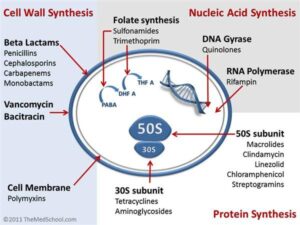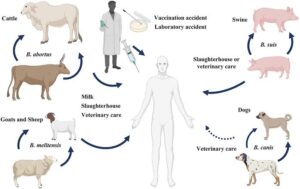Back to: MICROBIOLOGY 300 LEVEL
Welcome to class!
It’s always good to see you back! Today’s topic is very important, especially in our part of the world where misuse of antibiotics is common. We’re going to look at the types of antibiotics and how they work to fight infections. As a microbiology student, understanding antibiotics is not just about memorising names—it’s about knowing how they protect life, how resistance can build up, and how we can use them wisely to make sure they keep working for everyone.
Types Of Antibiotics And Their Modes Of Action
What are antibiotics?
Antibiotics are special medicines used to treat bacterial infections. They work by either killing bacteria or stopping them from growing. But they don’t work on viruses like the flu or COVID-19—that’s a common mistake many people make, even in hospitals across Nigeria.

Let’s now break down the types of antibiotics and how each one works.
1. Cell wall synthesis inhibitors
These antibiotics stop bacteria from building their cell walls, which leads to the bacteria bursting and dying.
Examples:
Penicillins (e.g. ampicillin)
Cephalosporins (e.g. ceftriaxone)
Carbapenems
How they work:
They block the enzymes that form the cell wall. Without this wall, bacteria become weak and die, especially Gram-positive bacteria.
Imagine trying to build a house without walls—the roof will collapse! That’s exactly what happens to bacteria under these antibiotics.
2. Protein synthesis inhibitors
These antibiotics block the bacteria’s ability to make proteins, which are needed for growth and survival.
Examples:
Tetracyclines (e.g. doxycycline)
Macrolides (e.g. erythromycin)
Aminoglycosides (e.g. gentamicin)
How they work:
They attach to the bacterial ribosomes and stop them from making proteins.
Think of this like a factory with its machines shut down. No products = no survival!
3. Nucleic acid synthesis inhibitors
These antibiotics interfere with the bacteria’s DNA or RNA, preventing them from copying themselves.

Examples:
Fluoroquinolones (e.g. ciprofloxacin)
Rifampicin
How they work:
They stop the enzymes needed for DNA replication or RNA transcription.
It’s like stopping a book from being photocopied. No copies, no bacteria multiplication.
4. Cell membrane disruptors
These damage the bacterial cell membrane, causing the contents to leak out and the cell to die.
Examples:
Polymyxins
Lipopeptides (e.g. daptomycin)
How they work:
They poke holes in the membrane—imagine water leaking out of a punctured sachet of pure water!
5. Antimetabolites
These antibiotics block essential bacterial enzymes involved in metabolism.
Examples:
Sulfonamides

Trimethoprim
How they work:
They mimic natural bacterial chemicals and trick the bacteria into using fake versions, which stops important processes like DNA formation.
Like giving fake fuel to a generator—it won’t run!
Summary
- Antibiotics can kill bacteria or stop them from growing.
- They work by attacking the bacterial cell wall, protein factories, DNA/RNA systems, cell membranes, or metabolism.
- Each type hasits specific way of stopping bacteria, and using the right antibiotic for the right infection is essential.
Evaluation
- What part of the bacteria do penicillins target?
- Why don’t antibiotics work against viruses?
- Give one example of an antibiotic that blocks protein synthesis.
Every concept you’re mastering brings you closer to making a real difference. You’re not just studying—you’re building skills that will impact health and save lives in your community and beyond. Keep going, stay curious, and know that Afrilearn is proud to walk this path with you. See you next lesson!
